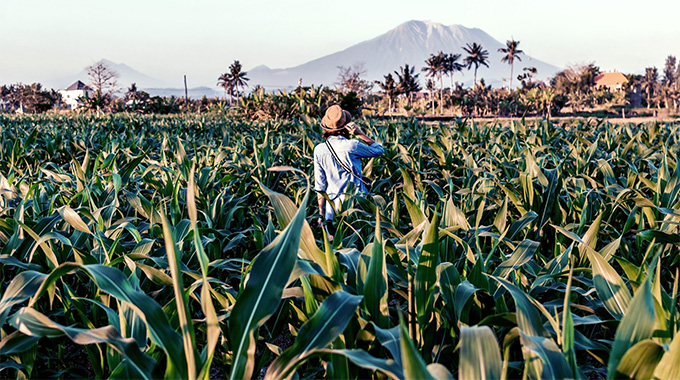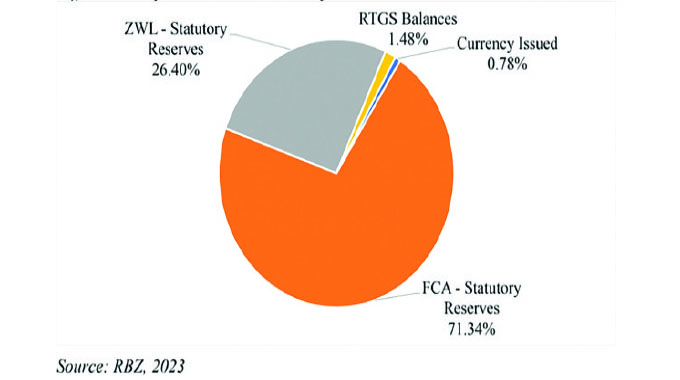Agripreneurship: Constitutive force for economic recovery

Dr Keen Mhlanga
Agricultural based economies are not growing at an increasing rate vindicating climate changes. The main cause for stagnant growth of countries which heavily depend on agriculture is the lack of ability to turn their farming activities into business.
Majority of Zimbabwean farmers take agriculture as a culture and they lack the integration of market positioning to an extent of selling their produce at low prices which are often set by buyers. Middlemen and dealers are gaining from farmers through their entrepreneurship skills and they are leaving actual farmers with little to sustain their families and reinvest in their businesses (green prison).
Entrepreneurs can escape this green prison by creating institution norms, property rights and legislations that provide incentives for competitive trading.
Agripreneurship is not only an opportunity but also a necessity for improving the production and profitability in agriculture and allied sector. It is the profitable marriage of agriculture and entrepreneurship which brings fruitful results, agriculture linked with entrepreneurship is central to dynamism and growth.
Agripreneurship is the need of hours to make agriculture more attractive and profitable venture.
The world’s third largest agricultural hub, India has 13 percent and 13,2 percent contribution to total export earnings and GDP from agriculture. In Zimbabwe agriculture takes 20,1 percentage points of the nation’s GDP and over 40 percent of export earnings.
Breaking down this composite in terms s of small scale and large scale farmers, 75 percent of Zimbabwe’s maize production comes from communal, A1, old resettlement and small scale commercial farmers and only a quarter from large scale and A2 farmers.
Farming must be seen as private entity and each family farm is a family business, agriculture ventures must be run as business enterprises and they must generate earnings.
As a result, the profitable in nature of agribusiness need policy makers who does not only opt for commercialisation, industrialisation and establishment mega farms as this will not facilitate supernormal growth in the next 50 years.
Small scale farming is the answer to a change beyond recognition and catalysed economic growth, considering land decline due to increasing population pressure.
Intensive small scale farming is not just desirable for poverty reduction only but also significant meeting surging and concentrated supply chains with more demanding buyers.
In addition to this, farm size, age of the farmer, education and caste does not hinder the success of agipreneurship.
Another eye opening angle is that agriculture is changing its landscape which is evidenced by urban farming, community gardens, farming on roof tops, hydroponics and temperature controlled systems. This innovation in agricultural systems can totally bury rural development and lead to heavily concentrated urban farming.
Considering the contribution of household, traditional and rural farming to both GDP and export earnings in Zimbabwe their collapse also means the collapse of the economy and their growth and productivity will definitely revive the economy.
The future of small holders reduce the burden of agriculture, control rural to urban migration, promotes industrial development in rural areas and absorbs pressure on urban cities.
In Asia the overall trend for the past years showed a decline in farm sizes and the agricultural sector is dominated by family farms yet the continent contributes a lot of supply in the world market.
Agriculture driven countries will benefit from the elimination of sustainability of natural resources, poverty reduction, food insecurity and unemployment. In Europe and America top four companies ranges from 50 percent to 81 percent market share in beef packing, corn exports, soya bean crushing, pork packaging, terminal grain handling facilities and soya exports. Small player impropotionaly gain on ethanol production, animal feed plants, pork production, broilers and turkey production.
The issue of an oligopoly structure in strong and developing economies has been suggested to promote par economic power and sound concentration of food systems within domestic players.
Agripreneurship bridge the gap between primary market and secondary market and allow producers to gain directly from their product without the use of middle men. The spread of growth between rural and urban areas is deeply affected by lack of marketing skills by rural entrepreneurs.
Land values are used as loan collateral in USA and steadily inflating land prices enabled farmers to borrow to expand their operations and continue operating.
The federal government imposed the Farmers Home Administration (FmHA) which is the last resort for all farmers who does not qualify for a loan from private sector and quasi-private sector institutions. Commercial and credible farmers use institutions like Federal Land banks, Federal Intermediate Credit Banks and Production Credit Association.
Catering for non-compliant farmers was a sound policy to ensure that all farmers are given the assistance they need to maximise production. When the FmHA delinquency rate doubled in 1982 to 25 percent, 7997 farmers quit farming.
Policies must breed fair trading ground to both the government and farmers, punitive interest rates in the USA reduced production and capacity utilisation from non-commercial farmers.
Such policy adjustments shape up an economy were the rich get richer and the poor get poorer, eroding the capability balance and equal opportunities among farmers.
Commercial farmers benefit from farm income and off-farm income averaging more than twice the amount of an average income per family in the USA.
The government offered non-recourse loan programmes in 1930s and this is still in effect for cotton and grains.
Farmers in this programme they put their grain under loan, if the market price is above the support price the farmer can buy back his grain for the original support price plus interest based on government’s cost of borrowing.
This is a cheap source of credit compared to commercial sources. Commodity Credit Corporation (CCC) offer another deal in which the farmer only pay the storage fee not the loan, if the market price is less than the support price.
In strong economies agricultural policies are market driven rather than being political driven and coated. The USA government was storing large quantities of grain and farmers were increasing their production. Increasing stock was reducing commodity prices, depressing farm income and increasing government farm expenditures. This gave birth to a more innovative approach called the Pay in Kind (PIK) programme which promote acreage reduction and the farmer was paid in grain for the idle acres. PIK reduced production and stock, encouraged adequate market supplies, minimised direct government outlays in support of agriculture, improved conservation practises, increased farm income and reduced storage costs.
Insuring and protecting farmers in the USA is done mostly by the government’s Agriculture and Consumer Protection Act of 1975, farmers receive disaster payment in the event of crop losses. In case of emergencies there is the Emergency Feed Programme which paid US$170 million in 1978.
Indian agricultural policies are driven and indirectly crafted by interest groups and lobbies. The Pre-green Revolution 1950-60s in India was heavily dependent on area expansion thus more acreage were attractive, size and space matters most. In 1970s they come up with an agriculture strategy called The Green Revolution technology which promote use of modern farm inputs and intensive farming. Lobbies then introduced diversification through global marketable channels by commercialising fisheries, poultry, dairy, fruits and vegetables. Liberalisation of market policies enables exporting these products without any jurisdiction.
A more conceptual Agricultural Risk Management set up is that of Australia which have National Drought Policy and the Emergency Circumstances policy (EC). The EC is based on 6 core criteria, (a) metrological conditions, (b) agronomic and stock condition, (c) water supplies, (d) environmental impacts, (e) farm income levels and (f) scale of the event. Moreover to help farmers to be more competent, profitable and sustainable in 1997 they launched the Agriculture Advancing Australia (AAA). The benefits of AAA include funding for business and natural resource management training and education, support for industries undergoing change, financial management tools, financing information and referral, funding professional advice, skills development training, assistance for farm families in serious financial difficulty and improved access to markets. Under AAA there is Farm Help programme which provide short term assistance to farm families experiencing severe problems, it offers up to $55 000 per family.
Sub Saharan Africa is dominated by policies which needs proper implementation and revitalisation of these policies to fit respective countries. Regional policies like the Common Agricultural Policy of the Economic Community of West African states, ECOWAS centralised in Ghana, lakes contribution and decision making from other state members. Kenya also had sector respective policies like dairy development policy, restructuring coffee industry, Cotton Amendment Act of 2006. Europe’s Common Agricultural Policy (CAP) makes Europe more self-sufficient. It ensures that farmers can continue to produce food even when the market conditions are not right therefore maintaining land and jobs.
Adopting the Australian approach on the issue of agriculture insurance can help and remove the burden of crisis management. A tax component can be allocated towards farmers and kept as a reserve in times of natural disasters, drought and other abnormal farming conditions. The government can insure and guarantee all farmers instead of private companies offering farm insurance packages. The most advantage of a centralised insurer which uses public funds is that all farmers will be equally covered were as an insurance firm only covers the contributor.
The world is becoming a global village and we must try and trade in foreign markets, our citrus fruits are best recognised in the international markets and we must try to produce quality and exportable products. Nigeria produces yams and it is the top producing country in the world, they are plenty of opportunities in Africa and unexhausted gaps in the international market. Exporting also enables foreign investments to boost local agri-businesses, especially if the investor knows the product and the company at a global level. Moreover it will bring in new foreign agricultural strategies and market related ideas.
Agriculture basics should be taught at colleges and universities, if we want to be a strong agricultural based economy it must be a compulsory subject just like Information and Technology. A farm must have all the necessary skills and education which is in line with operations carried out. Agriculture Advancing Australia (AAA) includes funding for business and natural resource management training and education, thus funding must be married with training and education.
Aggressively acquiring farms and randomly allocating people in areas which promote and sustain the economy will always have mismatching of resources, ability, skills and future expectations. Commercial farms were not strategically allocated, in fact farmers were supposed to be given at least one season and later on allocated in terms of their production. Deserving farmers were supposed to be given active farms with tractors and irrigation systems already in place. Farm history, achievements and previous financial statements were supposed to be the bases of assigning farms, what have been done can forecast better than what will happen to promote world class agronomists.
Urban and peri-urban farming sounds more attractive and farms along the highway and near the market place are more reasonable to own. Developmental finance calls for the drift from urban to rural and achieve an equal trading platform across the world. Remote areas have a lot of opportunities and a lot of unused land. Seasonal farmers migrate following rainfall patterns, crop farming is not the only cash generating practise, diversification and exploring other sectors like livestock can be wise, and 1 beast can buy 2 tonnes of maize and if ranching is done as a business it can sustain a farmer.
USA’s PIK promotes acreage reduction by paying farmers for acreage not used, we can have a policy which pays farmers if they use cost reduction measures, environmental friendly farming and mainly if they are profitable. Capital intensive adventures are prone to negative cash flows and negative operating income. There is need to transform cultural and home sustaining agriculture into profitable and development based farming. Farm bookkeeping should be practised by almost every farmer.
Keen Mhlanga is the founder and chairman of FinKing Financial Advisory. He can be contacted on [email protected]








Comments